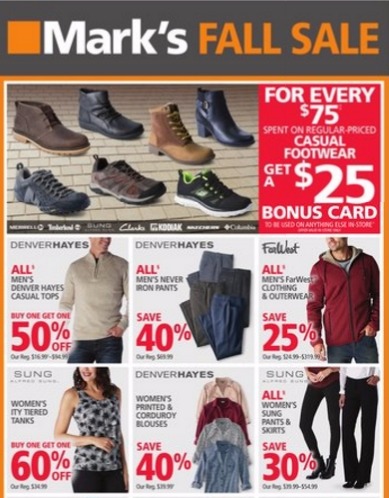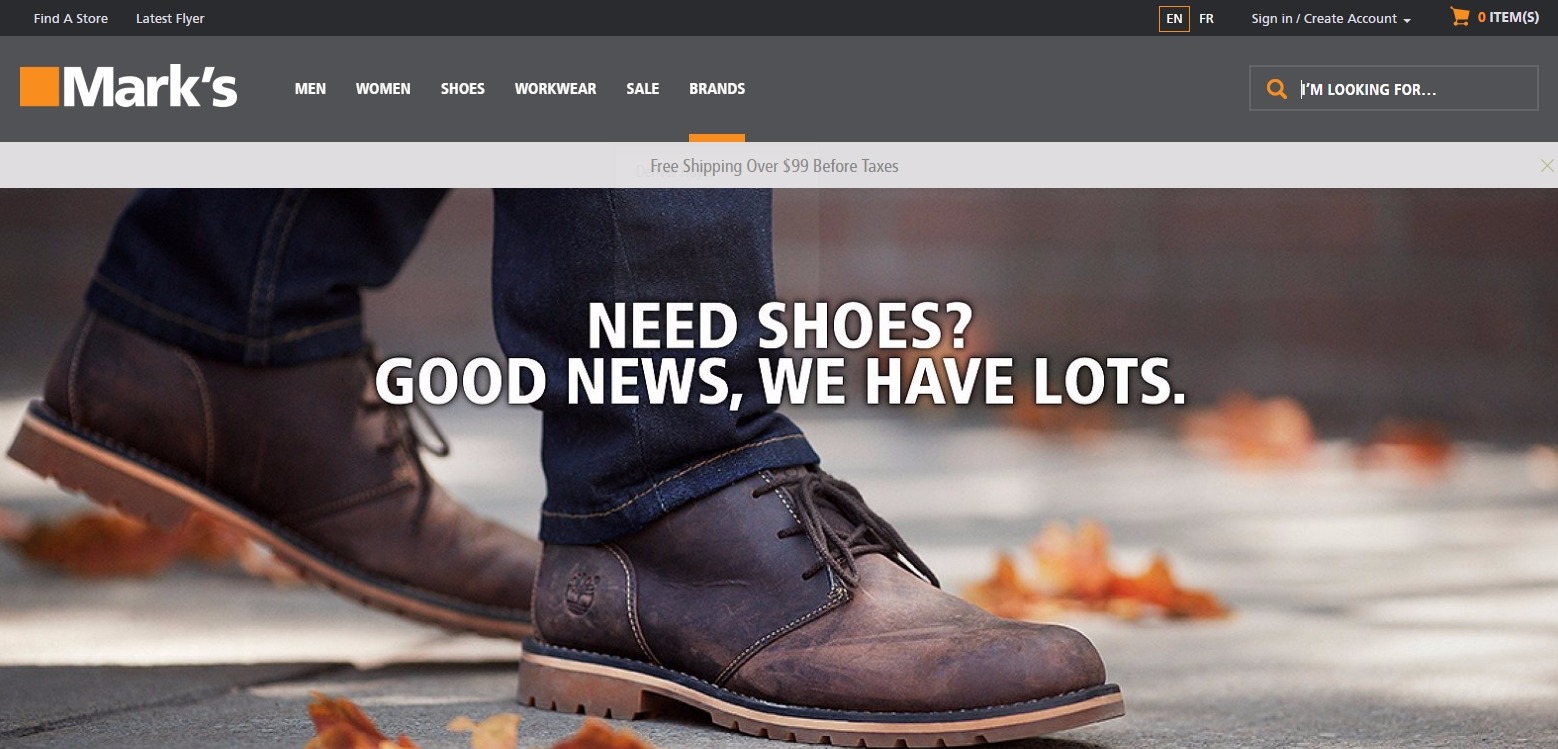How Canadian Apparel Retailer Mark's Grew From a Single Brick and Mortar to a 1.1B Brand

If you’re from the US, you might think we’re talking about a wealthy guy named Mark.
If you’re from Canada, you know we’re talking about a classic Canadian apparel retailer that’s been around for nearly 40 years.
Mark’s started out as a working man’s brick-and-mortar in Calgary, Alberta. Since then, Mark’s has grown to 380 stores across Canada—a 1.1 billion dollar powerhouse with an omnichannel presence.
We sat down with David Lui, the VP of Marketing at Mark’s and a retail industry thought leader for over 25 years, to discuss the ways this classic brand has managed to stay relevant since 1977.
Any company that’s been around as long as Mark’s is bound to run into massive shifts—not just in the marketplace, but in their own company offerings.
Marks has gone through not just a rebrand, but also an acquisition under massive Canadian Tire Corporation, a retail company that sells everything from, tires to toys.
And through it all, Mark’s has thrived.
“Mark’s started off as an industrial workwear attire to keep the working guys safe,” explains Lui. “It was entrepreneurial and still is even though they’ve been acquired by a corporate company.”

This can be attributed to two things: That entrepreneurial spirit, and a great fit with their new parent company.
 “Canadian Tire has been around 100 years,” says Lui. “That’s why we were a perfect fit for their family.”
“Canadian Tire has been around 100 years,” says Lui. “That’s why we were a perfect fit for their family.”
About 3-4 years ago, the company decided omnichannel growth was a focus, with a goal to become the #1 casual menswear company in Canada.
The retailer has also started to place a large focus on the Quebec market.
“The people of the province of Quebec still speak French,” Lui explains. “Our banner in Quebec is L’Équipeur. So we’re being locally relevant, and we just launched a French e-commerce website a year ago.”
When asked what the ideal Mark’s customer looks like (we guessed “outdoorsy”), Lui had a bigger answer ready.
“Canadians love the outdoors. Our target consumers are very humble and authentic and want comfort, style, and value. That’s who our customers are. Our brand’s promise is providing comfort, authenticity, reliability, and priced-right within the market.”
Canadians might have a reputation for being mild-mannered and relaxed, but that doesn’t mean they’re easily impressed by bland marketing campaigns. It’s those subtle culture-related quirks that require skill to tease out in an ad campaign.
Every quarter, Mark’s sends out a survey to Canadians asking about their perception of the brand. They then incorporate these findings into their campaigns.
“What we found in our research is our customers would welcome a bit of humor, and they want to be spoken to in that way. We call our fall campaign “No-Nonsense Living”–we cut to the chase and cut the clutter out of the language, and we insert a little humor.”
That pretty much sums up the series of fall-themed videos, which feature an outdoorsy clean-cut guy touting jeans that are “rugged enough that you can cut down a tree,” in a bold tone with a little humor thrown in. He’d fit right in as an alternate spokesman for Terry Crews in an Old Spice commercial.
This video has garnered over 1.2 million views since August, and Lui’s team took note.
“We took that data and we developed a campaign around bringing humor to our brand and how we speak to [our audience],” Lui says.
An even more successful ad campaign for Mark’s ran around Father’s Day this year.
“Father’s Day is a fundamental brand moment for Mark’s and its primary customers because Mark’s is the number one retailer for men’s casual wear and footwear in Canada, and Mark’s target demographic is males between the ages of 30–49.”
Typically, the retailer’s strategy around this hallmark moment has focused on tactical initiatives, but this time, Mark’s shifted its approach to be more emotional and moving and showcase an authentic point-of-view—the customer’s.
“As a part of the rebrand of Marks, we wanted to mostly engage with our customers more,” says Lui. “So Father’s Day was a natural fit. A lot of our customers are dads. Google asked us what we think the #1 search term on Father’s Day. The number one search was, “When is Father’s Day?”. We wanted to own that .”
To ensure Mark’s was top-of-mind for consumers, and to create a more authentic connection, the team developed an emotional Father’s Day video which they leveraged on both digital and social channels.
Watch the video below. (Fair warning: It’s a tear-jerker.)
This particular campaign boasted more than emotional clout, says Lui.
It generated significant traction across multiple social channels including over two million views on Facebook and YouTube.
Check out the breakdown:
The Mark’s team found this video boosted their customer’s willingness to recommend Mark’s to others. And vanity metrics aside, it also drove traffic into stores, according to Lui.
This has been a trend for Mark’s. Store visits aren’t going down due to online shopping. In fact, ecommerce improvements are helping to boost in-store conversions. (More on that later.)
Just like a pair of their durable jeans, Mark’s marketing strategy isn’t one-size-fits-all.
Mark’s works on both traditional and digital channels, and tailor-create a strategy with the help of creative external agencies and their in-house team.
Their increasing focus on digital means they’ve built relationships with both Google and Facebook. Like most successful apparel retailers, they recognize there’s value to investing in both channels.
“The majority of our digital spend on Google is on Search,” says Lui. “On the path to purchase, our consumers do a lot of searches, whether they’re looking for work boots, jeans—we want to be front-and-center on that search, and Google has been a strong partner in that.”
This heavy investment in search makes sense, considering the fact that currently, Google Shopping isn’t the star of the search result tabs yet for Google.ca (it’s under the “more” tab):

Facebook has helped take a favorite marketing tool of Mark’s pre-digital days, the common mailer or promotional flyer, and has helped them translate that in a digital space.

“In the past, our business has relied heavily on print flyers. Now, we create what we call a ‘digital flyer’ featuring products on a carousel ad on facebook. We’ve seen a +6-+12% in comp growth in that, and it tells us our customers heavily rely on digital to take the first step toward a purchase.”
In addition, Mark’s is taking advantage of Lookalike Audiences and Retargeting.
https://tinuiti.com/blog/2016/04/facebook-lookalike-audiences/
Mark’s has also invested in Facebook’s younger and more creative sister, Instagram. However, the strategy there is more top-of-the-funnel, with the creative team focusing on creating great content for that platform.
It’s obvious that Mark’s hasn’t adopted a strategy of jumping on every new trendy social platform in hopes that it will boost sales. The Mark’s team is just about to launch a Pinterest campaign, and it will strategically be geared toward certain categories.
Within the last 2-3 years (and much more over the last 2 years) Mark’s has focused on their digital expansion; particularly their ecommerce site, which is growing by about 75% this year compared to last year.

But the most interesting part of their ecommerce and online strategy is the fact that it isn’t their bottom-of-the-funnel channel. The online presence is a major drive-to-brick and mortar. In fact, the majority of their customers research products before they come into the store.
There are a few reasons ecommerce is successful at driving sales in-store. First, during the revamp, the team added a wider assortment of clothing options.
Secondly, they optimized the site for mobile. This is significant because over 50% of the traffic coming to Marks.com is from mobile devices.
While this may be a reflection of a global shift toward consumers browsing on mobile, there’s a more obvious reason why most sales aren’t closing online, but in-store.
“Our customers love the experiential aspect of our stores,” explains Lui. “We’re not in shopping malls. We’re a destination store. A lot of the guys and gals that come into our store already know what they want. They’re researching beforehand at home on desktop and mobile.”
Remember that entrepreneurial spirit we mentioned earlier? It’s the lifeblood of the company, and the main goal of the Mark’s team is ensuring they keep up on the pulse of their customers—including their preferences in technology.
“Innovation is one of our mantras,” Lui agrees. “We’re constantly looking at technology and how we can adopt those in our platforms. I looked into virtual reality, and it’s not right for Mark’s yet, but it could be. We’re going to be testing a couple of digital mirrors. We haven’t gone down the path where it could dress you in the fitting room, but something like a silent sales person.”
Despite these futuristic ideas, Mark’s doesn’t have plans to ditch traditional media outlets.
“Today, our digital spend continues to increase YOY as a part of our marketing expenditures, and we want to make sure we’re speaking to customers the same way wherever they are, even from a PR activation sense. We’re being a lot more visible on TV,” says Lui.
What it boils down to is an acute awareness of what the customer wants.
“We have a dedicated digital team that runs analytics and predictive analytics, and we’re expanding into personalization of content, relevant promotions, and ultimately looking at a program that builds the loyalty factor,” says Lui.
“At the end of the day, it’s about being wherever the customer wants to shop.”
